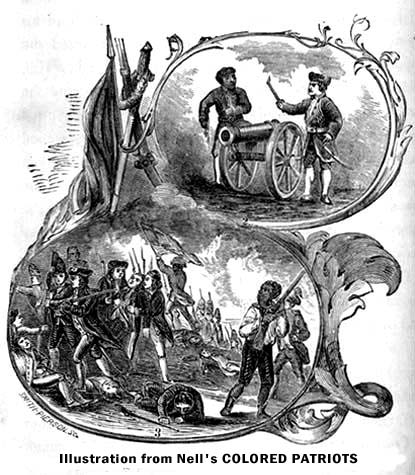| Colored Patriots of NH |
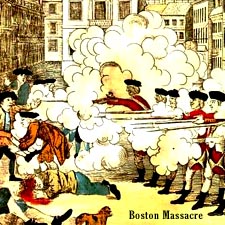
BLACK HISTORY
Yes, black Americans fought in both the Civil War and in the American Revolution. If not for WC Nell, a freed man who collected heroic tales, we might not know of these many African American patriots. Excerpted here is Nell’s brief section from his 1855 book on notables from Seacoast, New Hampshire.
America's first black historian, William C. Nell included a short chapter on NH patriots in his landmark book on African-Americans in the Revolution. HIs Abolitionist view of history opens with an illustration of Boston's Crispus Attucks felled in the Boston Massacre. Nell points out that a black citizen was the first martyr of the American Revolution.
Nell mentioned Jude Hall of Exeter and "Aunt Jenny" whom he refers to as NH's last slave. Nell's history is the key source of information about Portsmouth's Prince Whipple, slave to William Whipple who signed of the Declaration of Independence. Prince is mentioned, not in the short NH chapter reprinted here, but in the chapter on the state of Delaware. Nell places Prince there because he was reportedly in attendance to Gen. George Washington during his famous crossing of the Delaware River. In the NH chapter, Nell recounts an anecdote about a man enslaved under Durham's General John Sullivan. Other writers, including 19th century journalist Charles W, Brewster of Portsmouth, attribute that story to Prince Whipple. -- JDR
"Colored Patriots" of New Hampshire
By W.C. Nell, 1855
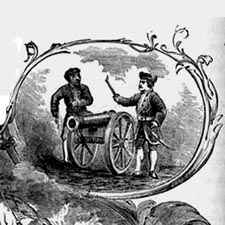 JUDE HALL was born at Exeter, N. H., and was a soldier in the Revolutionary War, under General Poor. He served faithfully eight years, and fought in most all the battles, beginning at Bunker Hill. He was called a great soldier, and was known in New Hampshire to the day of his death by the name of "Old Rock."
JUDE HALL was born at Exeter, N. H., and was a soldier in the Revolutionary War, under General Poor. He served faithfully eight years, and fought in most all the battles, beginning at Bunker Hill. He was called a great soldier, and was known in New Hampshire to the day of his death by the name of "Old Rock."
Singular to relate, three of his sons have been kidnapped at different times, and reduced to slavery. James was put on board a New Orleans vessel; Aaron was stolen from Providence, in 1807; William went to sea in the bark Hannibal, from Newburyport, and was sold in the West Indies, from whence he escaped after ten years of slavery, and sailed as captain of a collier from Newcastle to London.
The anecdote of the slave of Gen. Sullivan, of New Hampshire, is well known. When his master told him that they were on the point of starting for the army, to fight for liberty, he shrewdly suggested, that it would be a great satisfaction to know that he was indeed going to fight for his liberty. Struck with the reasonableness and justice of this suggestion, Gen. S. at once gave him his freedom.
It is not very surprising, that in the time of the Revolutionary War, when so much was said of freedom, equality, and the rights of man, the poor African should think that he had some rights, and should seek that freedom which others valued so highly. There were slaves then, even in New Hampshire, and their owners, like the Egyptians of old, and the Carolinians now, were unwilling to let them go." Here is an extract from the Journal of New Hampshire, touching this matter, showing how justice and humanity were postponed, as repentance often is, to a more convenient opportunity:-
"JUNE 9, 1780. Agreeable to order of the day, the petition of Negro Brewster and others, negro slaves, praying to be set free from slavery, being read, considered, and argued by counsel for petitioners before this House, it appears that at this time this house is not ripe for a determination in this matter. Therefore, ordered, That the further consideration of the matter be postponed till a more convenient opportunity."
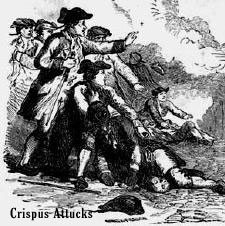 Senator Morrill, of New Hampshire, in his speech at Washington, in 1820, on the Missouri question, alluded to a colored man in his own State, by the name of Cheswell, who, with his family, were respectable in point of property, ability, and character. He held some of the first offices of the town in which he resided, was appointed Justice of the Peace for the county, and was perfectly competent to perform all the duties of his various offices in the most prompt, accurate, and acceptable manner.
Senator Morrill, of New Hampshire, in his speech at Washington, in 1820, on the Missouri question, alluded to a colored man in his own State, by the name of Cheswell, who, with his family, were respectable in point of property, ability, and character. He held some of the first offices of the town in which he resided, was appointed Justice of the Peace for the county, and was perfectly competent to perform all the duties of his various offices in the most prompt, accurate, and acceptable manner.
"In New Hampshire," says Dr. Belknap, in 1795, " those blacks who enlisted into the army for three years, were entitled to the same bounty as the whites. This bounty their masters received as the price of their liberty, and then delivered up their bills of sale, and gave them a certificate of manumission. Several of these bills and certificates were deposited in my hands; and those who survived the three years service were free." *
New Hampshire papers of a quite recent date record the death, at Hanover, of Mrs. JANE E. WENTWORTH a colored woman, at the age of three score and ten. Graduates at Dartmouth will recollect her as Aunt Jenny, the wash-woman, and nurse in sickness. Her parents were slaves, kidnapped when very young, and came by inheritance in possession of the family of Mrs. House, of Hanover. They were subsequently sold to a gentleman in Salem, NH, where they remained until they were emancipated by the laws of the State. Jenny was born in Hanover, in 1777, was sold with her parents, and upon becoming free, she married Charles Wentworth, a slave of Gov. Wentworth. They then removed to Hanover, where they remained till their death. Jenny outlived her husband several years, and was one of the last of the African race who in our early history were held in bondage in New England.
From Massachusetts Historical Collection, Vol. IV., p. 203.
Full title of Nell's book:
The Colored Patriots of the American Revolution, with Sketches of Several Distinguished Colored Persons, to which is added a Brief Survey of the Condition and Prospects of Colored Americans
FEATURED LINK: Read the book online
Commentary © SeacoastNH.com. First published online here in 1997. Updated 2005..
CONTINUE for more on WILLIAM COOPER NELL
About William Cooper Nell
(1816 – 1874)
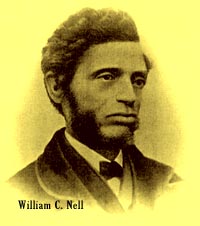 Best known today for his collected biographies of African-American patriots, abolitionist William C. Nell deserves much attention for his lifelong struggle for civil rights. Although he studied law, Nell refused to apply to the bar because he would not take an oath to a Constitution that did not recognize the rights of slaves. A native of Boston, Massachusetts, Nell campaigned to abolish separate schools for black children.
Best known today for his collected biographies of African-American patriots, abolitionist William C. Nell deserves much attention for his lifelong struggle for civil rights. Although he studied law, Nell refused to apply to the bar because he would not take an oath to a Constitution that did not recognize the rights of slaves. A native of Boston, Massachusetts, Nell campaigned to abolish separate schools for black children.
In 1851 he became assistant to Frederick Douglass and soon after published his own pamphlet on "Colored American Patriots" in the Revolution and the War of 1812. This evolved into the book for which he is best known and is excerpted here. Nell drew his stories from personal accounts, cemetery records and research. His book includes an introduction by abolitionist Harriet Beecher Stowe. She writes that reading Nell's book might "give new meaning and self-respect to the race here represented."
Some credit Nell with saving many black soldiers from obscurity. In his introduction, Nell hopes he can "rescue from oblivion" the heroic stories of his race. His account of the first martyr to the Revolution, Chrispus Attucks, brought a key black figure into American history at a time when almost all African-Americans were excluded. Nell's attempt to have a monument erected to Attucks was unsuccessful in 1851.
Nell is also credited as the first African-American to publish a significant collection of black biographies, though he was not a professional historian. A native free person, Nell wrote in what is described as the "naturalist idiom" popular in his time period and his focus was on soldiers and patriots. His work has, at times, been criticized as more enthusiastic than scholarly. William Nell is also distinguished as the first black American to hold a federal civilian post. He worked as a US postal clerk from 1861 until his death in 1874.
© SeacoastNH.com. First published online here in 1997. Updated 2005..
CONTINUE for illustrations from COLORED PATRIOTS
Engravings from Nell's 1855 History
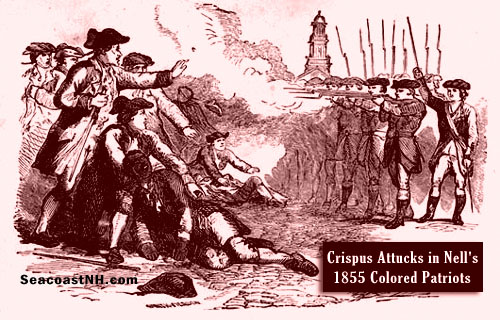
Frontispiece illustration from the 1855 edition of "Colored Patriots of the American Revolution" by W.C. Nell shows Crispus Attucks, the "first martyr of the American Revolution" fired on by British soldiers in Boston on March 5, 1770. Note the difference between this illustration and the equally imagainary engraving by Paul Revere (below) from which it was clearly adapted.

